Pleiotropic Effects of Statins
Pleiotropic Effects of Statins
Pleiotropic Effects of Statins
You also want an ePaper? Increase the reach of your titles
YUMPU automatically turns print PDFs into web optimized ePapers that Google loves.
<strong>Pleiotropic</strong> <strong>Effects</strong> <strong>of</strong> <strong>Statins</strong>verse group <strong>of</strong> drugs that share the ability to inhibithydroxymethylglutaryl coenzyme A reductase (HMG-CoA reductase), the enzyme that controls the ratelimitingstep <strong>of</strong> cholesterol synthesis, but this inhibitionis followed by other subsequences associated with themevalonate pathway (Figure 1).The clinically beneficial effects <strong>of</strong> statins were usuallyassumed to result from their ability to reduce cholesterolsynthesis. In 1994, the landmark ScandinavianSimvastatin Survival Study (4S) established the benefits<strong>of</strong> a HMG-CoA reductase inhibitor on mortality in patientswith atherosclerosis. 5 In accord with traditionalacceptance <strong>of</strong> atherosclerosis as a consequence <strong>of</strong> lipiddisorders, post-hoc analysis <strong>of</strong> the 4S trial suggested thatthe benefit provided by simvastatin in individual patientsindeed related to the magnitude <strong>of</strong> change in low-densitylipoprotein cholesterol. 10 Subsequent studies, however,differed with this conclusion even as they affirmed theclinical benefits <strong>of</strong> statins as a class on cardiovascularmorbidity and mortality in patients with or without establishedatherosclerotic disease. 6-9 These studies raisedquestions about additional beneficial effects <strong>of</strong> statins,because mevalonate, the product <strong>of</strong> the enzyme reaction,is the precursor not only <strong>of</strong> cholesterol but also <strong>of</strong> manynonsteroidal isoprenoid compounds, and inhibition <strong>of</strong>HMG-CoA reductase may produce pleiotropic effects(see Figure 1).Indeed, the mevalonate pathway yields a series <strong>of</strong>isoprenoids that are vital for diverse cellular functions. 11These isoprenoids include: isopentanyl adenosine, presentin some types <strong>of</strong> transfer RNA; dolichols, requiredfor glycoprotein synthesis; and polyisoprenoid sidechains <strong>of</strong> ubiquinone and heme A, involved in electrontransport. Several proteins have also been identified thatare post-translationally modified by the covalent attachment<strong>of</strong> mevalonate-derived isoprenoid groups-eitherfarnesyl or geranylgeranyl pyrophosphate. These proteinsmust be prenylated as a prerequisite for membraneassociation, which is required for their function. Members<strong>of</strong> this family are involved in a number <strong>of</strong> cellularprocesses, including cell signaling, cell differentiationand proliferation, myelination, cytoskeleton dynamics,Acetyl CoAHMG-CoAmevalonateHMG CoA reductaseisopentanyl – PP*geranyl-PP dekaprenyl-PP dekaprenyl 4OH benzoate CoQ10squalene farnesyl-PP farnesylated proteinscholesterolgeranylated proteins activation NFB** inflammationproliferation <strong>of</strong> SMC****PP – pyrophosphate**NFB – nuclear factor kappa B***SMC – smooth muscle cellsFigure 1. Cholesterol (mevalonate) synthesis pathway.191 Acta Cardiol Sin 2005;21:1908
Daniel Pella et al.and endocytotic/exocytotic transport.Hence, through the inhibition <strong>of</strong> HMG-CoA reductase,statins may affect a variety <strong>of</strong> processes; this mayhelp to explain their non-lipid-related pharmacologicproperties. Indeed, several recent in vitro and in vivo experimentshave demonstrated that HMG-CoA reductaseinhibitors have antiatherosclerotic effects that are not relatedto lipid lowering. Because <strong>of</strong> their broad effectsand their extremely low incidence <strong>of</strong> side effects, statinsmight even be seen as the new aspirin. 12The currently available statins are lovastatin, simvastatin,pravastatin, atorvastatin, fluvastatin and rosuvastatin.Cerivastatin was withdrawn from the marketin 2001 due to increased number <strong>of</strong> fatal rhabdomyolyses.13It seems that the process <strong>of</strong> metabolization <strong>of</strong> statinsis important from the safety point <strong>of</strong> view. Several <strong>of</strong>them are metabolized via cytochrome P450 (see Table1). 14-16 However, only a small proportion <strong>of</strong> rosuvastatinand fluvastatin are metabolized via cytochrome P4502C9, so there is no high risk <strong>of</strong> dangerous drug interactionsassociated with the use <strong>of</strong> these statins as well.Patients taking several drugs metabolized by the samecytochrome P450 are at higher risk <strong>of</strong> side effects <strong>of</strong>statins. Only two <strong>of</strong> the currently available statins arehydrophilic – pravastatin and rosuvastatin – this couldalso be important in prevention <strong>of</strong> “increased fluidity” <strong>of</strong>muscle cell membrane and then increased risk <strong>of</strong> myopathyor even rhabdomyolysis. 16 Antioxidant activities<strong>of</strong> statins differ (the greatest is observed in atorvastatin,with surprisingly much lower activity observed in rosuvastatin)and might be cardioprotective in two differentways. Firstly, statins decrease oxidation <strong>of</strong> LDL cholesterolparticles, and secondly, they have protective effecton myocyte membrane in ubiquinone deficiency whichmay appear during long-term statin therapy. 16,18The main action <strong>of</strong> statins is to specifically and reversiblyinhibit HMG-CoA reductase, which controls therate-limiting step in cholesterol synthesis. Several studieshave compared lipid-lowering effects <strong>of</strong> differentstatins head to head. In one <strong>of</strong> the latest, STELLARstudy, rosuvastatin in the dosage <strong>of</strong> 40 mg was moreeffective than all currently available statins in all recommendeddoses. LDL cholesterol was lowered by 55%with rosuvastatin 40 mg daily. 19These differences in efficacy were confirmed in ameta-analysis <strong>of</strong> 164 studies published in 2003. Herealso, the different statins showed a two- to three-fold differencein the extent <strong>of</strong> LDL cholesterol lowering acrossthe dosage range. 20The effect on HDL cholesterol was compared aswell in the STELLAR study. It was shown that rosuvastatinhad the greatest potency to increase HDL cholesterol,followed by simvastatin and atorvastatin (maximalincrease 9.6% vs 6.8% vs 5.7%). 21 The recent study <strong>of</strong>Bevilacqua showed different results. 22 Compared werefluvastatin extended release form 80 mg daily, whichwas superior to atorvastatin 20 mg daily. However, ingeneral, statins have much lower potency to increaseHDL in comparison with fibrates or nicotinic acid.Surprisingly, it was shown in the MIRACL trial thathigh-density lipoprotein, but not low-density lipoproteincholesterol levels, influenced short-term prognosis afteracute coronary syndrome, and this finding suggested thatthe clinical benefit <strong>of</strong> atorvastatin after acute coronarysyndrome was mediated by qualitative changes in theTable 1. Characteristics <strong>of</strong> statinsAtorvastatin Lovastatin Pravastatin Simvastatin Fluvastatin RosuvastatinDose range (mg/dL) 10-80 10-80 10-80 10-80 20-80 5-40Maximal LDL-C reduction (%) 60 40 34 47 24 55Serum triglyceride reduction (%) 29 16 24 18 10 43Serum HDL-C increased (%) 6 8.6 12 12 8 9,2Penetration to CNS No Yes No Yes No NoRenal excretion (%) 2 10 20 13 < 6 10Mechanism <strong>of</strong> hepatic metabolism Cytochromep-450 3A4Cytochromep-450 3A4Sulfation Cytochromep-450 3A4Cytochromep-450 2C9(small proportion)Cytochromep-450 2C9(small proportion)Hydro/lipophilic properties lipophilic lipophilic hydrophilic lipophilic lipophilic hydrophilicActa Cardiol Sin 2005;21:1908
<strong>Pleiotropic</strong> <strong>Effects</strong> <strong>of</strong> <strong>Statins</strong>LDL particle and/or by non-lipid (pleiotropic) effects <strong>of</strong>the drug. 23PLEIOTROPIC EFFECTS – DEFINITIONDrugs usually have multiple effects; through an analogywith single genes which affect more than onesystem or determine more than one phenotype, they arecurrently referred to as “pleiotropic effects” (from theGreek “pleion,” meaning more, and “tropos,” meaningdirection or turn). These may be related or unrelated toprimary mode <strong>of</strong> action <strong>of</strong> the drug. <strong>Pleiotropic</strong> effectsmay emerge during preclinical and clinical studies indrug development, but more <strong>of</strong>ten than not, they are discovereda posteriori long after the therapeutic agent ismarketed (the same situation occurs in use <strong>of</strong> statins).They may be undesirable and recognized as adverse sideeffects, they may be neutral, or they may be beneficial,enhancing the desirable effect <strong>of</strong> a drug. 24ANTIATHEROGENIC PLEIOTROPICEFFECTS OF STATINSThe most important pleiotropic antiatherogenic effects<strong>of</strong> statins are improvement <strong>of</strong> endothelial dysfunction,antioxidative properties, antiinflammatory, antiproliferativeand antithrombotic effects and neoangiogenesis.25 <strong>Statins</strong> inhibit by blocking HMG-CoA reductase,and also by blocking synthesis <strong>of</strong> geranylated proteinsresponsible for proliferation and migration <strong>of</strong> smoothmuscle cells from vessel media to intima and their conversionfrom contractile to reparatory type which arecauses growth <strong>of</strong> atherosclerotic plaque. Also, synthesis<strong>of</strong> farnesylated proteins is inhibited, that is why also activity<strong>of</strong> nuclear factor kappa B is decreased. This factorplays very important role in the initiation <strong>of</strong> inflammatoryprocess-atherosclerosis is inflammatory disease. 26<strong>Statins</strong> and Endothelial DysfunctionAbnormal endothelium-dependent vasomotor responsespredict the long-term progression <strong>of</strong> atherosclerosisand associated coronary events, as well as eventsafter vascular surgery. 27,38 <strong>Statins</strong> are able to increase nitricoxide synthesis and improve blood flow dependentupon endotheliumm, as was shown in study <strong>of</strong> Marchesiet al. with atorvastatin and other statins. 29,30<strong>Statins</strong> and Antiinflammatory <strong>Effects</strong>Recent research has shown that inflammation plays akey role in coronary artery disease and other manifestations<strong>of</strong> atherosclerosis. Immune cells dominate earlyatherosclerotic lesions, and activation <strong>of</strong> inflammationcan elicit acute coronary syndromes. Elevated markersfor inflammation such as CRP, interleukin-6, intercellularadhesion molecule-1 (ICAM-1), and serumamyloid A have been associated with increased risk forthe first and reccurent cardiovascular events. 31 Many experimentaland clinical studies confirmed significantreduction <strong>of</strong> CRP measured by high sensitive method (hsCRP). The higher the baseline value <strong>of</strong> CRP, the higherthe decrease that has been observed, e.g. in the PROVEIT study. 32 In that study, decrease <strong>of</strong> hs CRP achieved89% in the atorvastatin group and 85% in the pravastatingroup. Generally, the greatest decreases <strong>of</strong> hs CRP wereobserved after treatment with atorvastatin or rosuvastatin.Increased levels <strong>of</strong> CRP were associated withmore pronounced monocyte migration and increasedLDL uptake by macrophages. 33<strong>Statins</strong> and Plaque Growth<strong>Statins</strong> have antiproliferative effects and inhibittransformation <strong>of</strong> contractile smooth muscle cells toreparatory-type cells and their migration from arterialmedia into intima. 34 <strong>Statins</strong> decrease synthesis <strong>of</strong> extracellularmatrix and proteins Rac1, Rho A as well, andby this means decrease plaque growth. 35Substantial differences have been found between thestatins. For example, in the ASAP study, it was shownthat at the highest therapeutic dose, two years <strong>of</strong> treatmentwith atorvastatin reduced the thickness <strong>of</strong> thearterial wall, while after simvastatin treatment, the thickness<strong>of</strong> the arterial wall continued to increase. 36 Similarresults were achieved in the ARBITER study whenatorvastatin and pravastatin were compared. 37 In a veryrecent study, REVERSAL, where intravascular ultrasoundmethod was used to quantify atherosclerosis, after18 months <strong>of</strong> therapy with atorvastatin 80 mg daily, volume<strong>of</strong> the atherosclerotic plaque slightly decreased,while the volume <strong>of</strong> the plaque continued to increaseduring therapy with pravastatin 40 mg daily. 38193 Acta Cardiol Sin 2005;21:1908
Daniel Pella et al.<strong>Statins</strong> and Angiogenesis<strong>Statins</strong> are able to activate proteinkinase Akt in endothelialcells and thereby stimulate activity <strong>of</strong> endothelialnitric oxide synthethase leading to increased NOproduction and neoangiogenesis. Stimulation <strong>of</strong> proteinkinaseAkt improves myocardial aerobic metabolism.<strong>Statins</strong> increase also the level <strong>of</strong> angiopoetine. 39<strong>Statins</strong> and Plaque Rupture<strong>Statins</strong> significantly reduce metalloproteinases activity,mainly <strong>of</strong> MMP1 and MMP3, which play importantroles in plaque rupture or fissuration. 40 Decrease <strong>of</strong>blood pressure observed during long-term treatment withstatins lead to improvement <strong>of</strong> rheology and arterialstiffness. 41<strong>Statins</strong> and Thrombosis<strong>Statins</strong> have capacity to decrease global fibrinolyticactivity <strong>of</strong> the blood, decrease activity <strong>of</strong> PAI-1 and inhibitthrombine generation. Data regarding influence <strong>of</strong>statins on fibrinogen levels are not so convincing. 42<strong>Statins</strong> and Plaque StabilityThere were several pleiotropic effects <strong>of</strong> statins describedwhich should be responsible for the stability <strong>of</strong>the atherosclerotic plaque. Nevertheless, the most importantfinding for plaque stability is the combination <strong>of</strong>lipid-lowering effects with pleiotropic ones (especiallydecrease <strong>of</strong> plaque lipid core size and inhibition <strong>of</strong> inflammatoryreaction). 43Possible Negative <strong>Pleiotropic</strong> <strong>Effects</strong> <strong>of</strong> <strong>Statins</strong>Inhibition <strong>of</strong> HMG-CoA reductase leads not only todecreased synthesis <strong>of</strong> cholesterol but also affects synthesis<strong>of</strong> other substances. Besides these positive pleiotropiceffects, there is probably also a negative one,namely, inhibition <strong>of</strong> geranyl pyrophosphate synthesisand subsequently dekaprenyl-4-bensoate, which is a precursor<strong>of</strong> coenzyme Q10. Coenzyme Q10 (ubiquinone,ubidekarenone) is a very important substance in myocardialenergetic metabolism and the stability <strong>of</strong> cellmembrane as well; when deficient, myocytes could beprone to damage in the form <strong>of</strong> myopathy or myositis, oreven rhabdomyolysis. 44 Deficiency <strong>of</strong> coenzyme Q10will appear usually after longer duration <strong>of</strong> treatment andmay also be dependent on type <strong>of</strong> statin and its dosage.Given the fact that statins will be prescribed morewidely (“... statins to every patient with documented coronaryartery disease...” Yusuf S, Lancet 2002), it is veryimportant to consider the safety <strong>of</strong> such therapy. 45 Statintherapy is long-term (even life-long, following evidence-basedmedicine), so the risk <strong>of</strong> adverse effectsmight be increased. More clinical studies are needed inorder to confirm the beneficial effects <strong>of</strong> coenzyme Q10substitution in long-term statin therapy. The InternationalCollege <strong>of</strong> Cardiology, in its scientific statement,recommended use <strong>of</strong> statins preferably in conjunctionwith coenzyme Q10 in order to prevent possible myopathy.46The recently published hypothesis by Moosmannand Behl has identified a possible role <strong>of</strong> deficiency <strong>of</strong>selenium and association with possible adverse effects <strong>of</strong>statins, namely myopathy and polyneuropathy. 47 Theynoted that the pattern <strong>of</strong> side effects associated withstatins resembled the pathology <strong>of</strong> selenium deficiency,and postulated that the mechanism lay in a wellestablishedbut <strong>of</strong>ten overlooked biochemical pathway –the isopentylation <strong>of</strong> selenocysteine-tRNA. A negativeeffect <strong>of</strong> statins on selenoprotein synthesis does seem toexplain many <strong>of</strong> the enigmatic effects and side effects <strong>of</strong>statins, in particular, statin-induced myopathy.In a recent study, Silver et al. evaluated left ventriculardiastolic function with Doppler echocardiographybefore and after statin therapy. Statin therapy worseneddiastolic parameters in most patients; coenzyme Q10supplementation in patients with worsened diastolicfunction with statin therapy improved parameters <strong>of</strong> diastolicfunction. 48Similar results were confirmed in the study <strong>of</strong>Kumar et al. in more than 100 studied subjects (the study<strong>of</strong> Silver et al. evaluated only 14 patients). 49What is very important to say is that statins are generallyvery well tolerated drugs and a remarkably safe class<strong>of</strong> lipid lowering agents. These data probably lead to thefact that in the United Kingdom simvastatin is now availablein pharmacies without medical prescription. 50PLEIOTROPIC EFFECTS OF STATINS INNON-ATHEROSCLEROTIC DISEASEAntiproliferative and antiinflammatory effects <strong>of</strong>Acta Cardiol Sin 2005;21:1908
<strong>Pleiotropic</strong> <strong>Effects</strong> <strong>of</strong> <strong>Statins</strong>Table 2. Possible beneficial pleiotropic effects <strong>of</strong> statins in non-atherosclerotic diseasesfibrosclerotic aortic stenosissudden cardiac death preventionarterial hypertensiondeep venous thrombosisAlzheimer’s dementiaregression <strong>of</strong> left ventricular hypertrophyrheumatic diseases (rheumatoid arthritis)osteoporosissclerosis multiplexvitiligostatins have raised questions about possible use <strong>of</strong> statinsin diseases other than atherosclerosis, cardiovascular andnon-cardiovascular. Many clinical studies are in progresswhich probably should enlighten us on their relativeclinical relevance and importance. Some <strong>of</strong> the diseasesinvolved in this research are listed in Table 2. 51CONCLUSIONS<strong>Statins</strong> have the same mode <strong>of</strong> action via inhibition<strong>of</strong> HMG-CoA reductase activity but differ between eachother in the extent <strong>of</strong> this inhibition, which leads to differentlevels <strong>of</strong> LDL cholesterol lowering. Due to thisfact, not only cholesterol synthesis inhibited is but als<strong>of</strong>ormation <strong>of</strong> inflammatory proteins, substances associatedwith smooth muscle cells proliferation and endogenoussynthesis <strong>of</strong> coenzyme Q10.Although the possibility that statins might havepleiotropic effects was met at first with healthy scepticism,the vast amount <strong>of</strong> knowledge accrued over thepast few years has moved these effects into the spotlight.<strong>Pleiotropic</strong> effects <strong>of</strong> statins are numerous and varied,they may add to the desirable effect <strong>of</strong> a drug or be undesirableand interfere with the treatment. As the list <strong>of</strong>pleiotropic effects effects <strong>of</strong> statins is expanding rapidly,it will become essential to establish their relative biologicalsignificance and clinical relevance.LDL cholesterol indubitably represents a modifiablekey risk factor for atherosclerosis, and lowering LDL-Cblood levels certainly diminishes cardiovascular risk inthe long term. The current flurry <strong>of</strong> interest in the socalledpleiotropic effects <strong>of</strong> statins should in no waydeter practitioners from aggressive management <strong>of</strong> dyslipidemia,a long established risk factor, as mandated bycurrent guidelines. Nevertheless, it will be important totake action on the new indications which have emergedfrom consideration <strong>of</strong> possible pleiotropic effects.Further study <strong>of</strong> pleiotropic functions <strong>of</strong> statins mayprovide insights into the biology <strong>of</strong> atherosclerosis (andother diseases e.g. osteoporosis, rheumatoid arthritis,connective tissue diseases, etc.) that could yield benefitsin terms <strong>of</strong> targeting and developing novel strategies thatwill address the residual burden <strong>of</strong> atherosclerotic complicationsthat plague even those individuals who achievedcurrent lipid goals.REFERENCES1. World Health Organization. The World Health Report 2002:Reducing risks, promoting healthy life. Geneva: World HealthOrganization; 2002.2. American Heart Association. Statistical fact sheet — populations.International Disease Statistics. Dallas, T: American HeartAssociation; 2003.3. Endo A, Kuroda M, Tanarawa K. Competitive inhibition <strong>of</strong>3-HMG-CoA reductase by ML 236 A and ML 236 B. Febs Lett1976;72:323-6.4. Roberts JR. Lipid-lowering drugs in atherosclerosis. Am JCardiol 1996;89:682.5. Simvastatin Survival Study Group. Randomized trial <strong>of</strong>cholesterol lowering in 4444 patients with coronary heart disease:the Scandinavian Simvastatin Survival Study (4S). Lancet1994;334:1383-9.6. Sacks FM, Pfeffer MA, Moye LA. The effect <strong>of</strong> pravastatin oncoronary events after myocardial infarction in patients withaverage cholesterol levels. N Eng J Med 1996;335:1001-9.7. The Long-term Intervention with Pravastatin in IschaemicDisease (LIPID) Study Group. Prevention <strong>of</strong> cardiovascularevents and death with pravastatin in patients with coronary heartdisease and broad range <strong>of</strong> initial cholesterol levels. N Eng J Med1998;339:1349-57.8. West <strong>of</strong> Scotland Coronary Prevention Group. West <strong>of</strong> ScotlandCoronary Prevention Study: identification <strong>of</strong> High-risk Groupsand Comparison with Other Cardiovascular Intervention Trials.Lancet 1996;346:1339-42.9. Downs JR, Clearfield M, Weis S. Primary prevention <strong>of</strong> acutecoronary events with lovastatin in men and women with averagecholesterol levels. N Eng J Med 1999;339:1615-22.195 Acta Cardiol Sin 2005;21:1908
Daniel Pella et al.10. Pedersen TR, Olsson AG, Faergeman O, et al. For the SimvastatinSurvival Study Group. Lipoprotein changes and reduction in theincidence <strong>of</strong> major coronary heart disease events in theScandinavian Simvastatin Survival Study (4S). Circulation1998;97:1453-60.11. Corsini A, Bellosta S, Baetta R, et al. New insights into thepharmacodynamic and pharmacokinetic properties <strong>of</strong> statins.Pharmacol Ther 1999;84:413-28.12. Veillard NR, Mach F. <strong>Statins</strong>: The new aspirin? Cell Mol Life Sci2002;59:1771-86.13. Staffa JA, Chang J, Green L. Cerivastatin and reports <strong>of</strong> fatalrhabdomyolysis. N Eng J Med 2002;346:539-40.14. ACC/AHA/NHLBI Clinical Advisory on <strong>Statins</strong>: clinicaladvisory on the use and safety <strong>of</strong> statins. JACC 2002;40:567-72.15. Chong P, Seeger J, Franklin C. Clinically relevant differencesbetween the statins: implications for the therapeutic selection. AmJ Med 2001;111:390-400.16. Chiang CE, Pella D, Singh RB. Coenzyme Q10 and adverseeffects <strong>of</strong> statins. J Nutritional and Environmental Med 2004;14:1-12.17. Shepherd J. Fibrates and statins in the treatment <strong>of</strong> hyperlipidaemia:an appraisal <strong>of</strong> their efficacy and safety. Eur Heart J 1995;16:5-13.18. Mason RP, Jacob RF. Membrane microdomains and vascularbiology: emerging role in atherogenesis. Circulation 2003;107:2270-3.19. McKenney JM, Jones PH, Adamczyk MA. For the STELLARStudy Group. Comparison <strong>of</strong> efficacy <strong>of</strong> rosuvastatin versusatorvastatin, simvastatin, and pravastatin in achieving lipid goals:results from the STELLAR trial. Curr Med Res Opin 2003;19:557-66.20. Law MR, Wald NJ, Rudnicka AR. Quantifying effect <strong>of</strong> statins onlow-density lipoprotein cholesterol, ischaemic heart disease, andstroke: systematic review and meta-analysis. BMJ 2003;326:1423.21. Schuster H, Fox JC. Investigating cardiovascular risk reduction:the Rosuvastatin GALAXY Programme. Expert OpinPharmacother 2004;5:1187-1200.22. Bevilacqua M, Guazzini B, Righini V, et al. Metabolic effects <strong>of</strong>fluvastatin extended release 80 mg and atorvastatin 20 mg inpatients with type 2 diabetes mellitus and low serum high-densitylipoprotein cholesterol levels: a 4-month, prospective, open label,randomised, blinded-end point (Probe) trial. Curr Ther Res2004;65:330-44.23. Olsson AG, Schwartz GG, Szarek M, et al. High-densitylipoprotein, but not low-density lipoprotein cholesterol levelsinfluence short-term prognosis after acute coronary syndrome:results from the MIRACL trial. Eur Heart J 2005;26:890-6.24. Davignon J. The pleiotropic effects <strong>of</strong> drugs affecting lipidmetabolism. Atherosclerosis XI. Paris: Elsevier, 1998;63-77.25. Davignon J. Beneficial cardiovascular pleiotropic effects <strong>of</strong>statins. Circulation 2004;109(suppl III):III-39-III-43.26. Schoenbeck U, Libby P. Inflammation, immunity, and HMG-CoA reductase inhibitors: statins as antiinflammatory agents?Circulation 2004;109(suppl II):II-18-II-26.27. Schächinger V, Britten MB, Zeiher AM. Prognostic impact <strong>of</strong>coronary vasodilator dysfunction on adverse long-term outcome<strong>of</strong> coronary heart disease. Circulation 2000;101:1899-906.28. Gokce N, Keaney JF Jr, Hunter LM, et al. Risk stratification forpostoperative cardiovascular events via noninvasive assessment<strong>of</strong> endothelial function: a prospective study. Circulation 2002;105:1567-72.29. Marchesi S, Lupattelli G, Schillaci G, et al. Short-term atorvastatintreatment improves endothelial function in hypercholesterolemicwomen. J Cardiovasc Pharmacol 2000;36:617-21.30. Forgione MA, Leopold JA, Loscalzo J. Roles <strong>of</strong> endothelialdysfunction in coronary artery disease. Curr Opin Cardiol2000;15:409-15.31. Lindahl B, Toss H, Siegbahn A, et al. Markers <strong>of</strong> myocardialdamage and inflammation in relation to long-term mortality inunstable coronary artery disease. N Eng J Med 2000;343:1139-47.32. Cannon CP, Braunwald E, McCabe CH, et al. Comparison <strong>of</strong>intensive and moderate lipid lowering with statins followingacute coronary syndromes. N Eng J Med 2004;350:1495-504.33. Zwaka TP, Hombach V, Torzewski J. C-reactive protein-mediatedlow-density lipoprotein uptake by macrophages: implications foratherosclerosis. Circulation 2001;103:1194-7.34. Weissberg PL. Atherogenesis: current understanding <strong>of</strong> thecauses <strong>of</strong> atheroma. Heart 2000;83:247-52.35. Nakagami H, Jensen KS, Liao JK. A novel pleiotropic effect <strong>of</strong>statins: prevention <strong>of</strong> cardiac hypertrophy by cholesterolindependentmechanisms. Ann Med 2003;35:398-403.36. Smilde TJ, van Wissen S, Wollersheim H, et al. Effect <strong>of</strong>aggressive versus conventional lipid lowering on atherosclerosisprogression in familial hypercholesterolemia (ASAP): aprospective, randomised, double-blind trial. Lancet 2001;357:577-81.37. Taylor AJ, Kent SM, Flaherty PJ, et al. ARBITER: ArterialBiology for the Investigation <strong>of</strong> the Treatment <strong>Effects</strong> <strong>of</strong>Reducing Cholesterol: a randomized trial comparing the effects<strong>of</strong> atorvastatin and pravastatin on carotid intima medial thickness.Circulation 2002;106:2055-60.38. Nissen SE, Tuzcu EM, Schoenhagen P, et al. REVERSALinvestigators. Effect <strong>of</strong> intensive? compared with moderatelipid-lowering therapy on progression <strong>of</strong> coronary atherosclerosis:a randomized controlled trial. JAMA 2004;291:1071-80.39. Kaski JC. Infection, endothelial dysfunction, and atherogenesis.Circulation 2003;108:E171-2.40. Callahan AS 3rd. Vascular pleiotropy <strong>of</strong> statins: clinical evidenceand biochemical mechanisms. Curr Atheroscler Rep 2003;5:33-7.41. Borghi C, Dormi A, Veronesi M, et al. Association betweendifferent lipid-lowering treatment strategies and blood pressurecontrol in the Brisighella Heart Study. Am Heart J 2004;148:285-92.Acta Cardiol Sin 2005;21:1908 196
<strong>Pleiotropic</strong> <strong>Effects</strong> <strong>of</strong> <strong>Statins</strong>42. Levy Y. Beyond cholesterol lowering: effect <strong>of</strong> statins on markers<strong>of</strong> cardiovascular disease. Isr Med Assoc J 2004;6:490-1.43. Crisby M, Nordin-Fredriksson G, Shah PK, et al. Pravastatintreatment increases collagen content and decreases lipid content,inflammation, metalloproteinases, and cell death in humancarotid plaques: implications for plaque stabilization. Circulation2001;103:926-33.44. Singh, RB, Pella D, Chopra BP, et al. Overview <strong>of</strong> ubiquinone, inmemory <strong>of</strong> a champion, Dr. Emile G. Bliznakov. J <strong>of</strong> Nutr andEnviroment Med 2003;13:211-4.45. Yusuf S. Two decades <strong>of</strong> progress in preventing vascular disease.Lancet 2002;6:2-3.46. Pella D, Singh RB, Tomlinson B, et al. Coronary artery disease indeveloping and newly industrialised countries: a scientificstatement <strong>of</strong> the International College <strong>of</strong> Cardiology. In: Frontiersin Cardiovascular Health. Boston: Kluwer Academic Publishers,2003:473-87.47. Moosmann B, Behl C. Selenoprotein synthesis and side effects <strong>of</strong>statins. Lancet 2004;363:892-4.48. Silver MA, Langsjoen PH, Szabo S, et al. Effect <strong>of</strong> atorvastatin onleft ventricular diastolic function and ability <strong>of</strong> coenzyme Q10 toreverse that dysfunction. Amer J Cardiol 2004;94:1306-10.49. Kumar A, Kaur H, Kumar S, et al. Atorvastatin alone/incombination with coenzyme Q10 in 103 cases <strong>of</strong> heart failure dueto ischemic cardiomyopathy. In: Abstract book from the FourthConference <strong>of</strong> the International Coenzyme Q10 Association. LosAngeles 2005:54-6.50. Nash DB, Nash SA. Reclassification <strong>of</strong> simvastatin to overthe-counterstatus in the United Kingdom: a primary preventionstrategy. Am J Cardiol 2004;94:35F-39F.51. Doggrell SA. New targets and new drugs down under in 2004.Drug News Perspect 2005;18:149-60.197 Acta Cardiol Sin 2005;21:1908
Review ArticleActa Cardiol Sin 2005;21:190−8高 血 脂 治 療 藥 物 STATIN 的 多 重 作 用Daniel Pella Rafael Rybar Viola Mechirova1st Internal Clinic, Faculty <strong>of</strong> Medicine PJ Safarik University Kosice, Slovakia近 十 年 來 , 對 於 改 善 血 脂 肪 異 常 與 預 防 缺 血 性 心 臟 病 之 間 的 研 究 逐 漸 開 展 。 對 於 建 立新 的 治 療 標 的 與 研 發 新 的 高 血 脂 治 療 藥 物 也 拓 展 臨 床 治 療 的 選 擇 。 不 論 病 人 是 否 具 有 冠 狀動 脈 心 臟 病 ,STATIN 已 成 為 降 低 血 膽 固 醇 值 與 心 血 管 疾 病 併 發 症 最 主 要 及 最 有 效 的 藥 物 。最 近 研 究 指 出 ,STATIN 在 治 療 心 血 管 疾 病 的 好 處 , 不 僅 僅 只 從 降 低 血 膽 固 醇 值 方 面 解釋 。 一 些 改 善 血 脂 肪 異 常 以 外 的 效 果 , 如 抗 發 炎 、 抗 增 生 及 抗 血 栓 效 果 , 以 及 改 善 內 皮 細胞 功 能 等 , 也 扮 演 部 份 角 色 , 本 文 將 對 這 些 改 善 血 脂 肪 異 常 外 之 多 重 作 用 (extra-lipidpleiotropic effects) 作 概 略 介 紹 。關 鍵 詞 : 高 血 脂 治 療 藥 物 、 降 血 脂 外 多 重 作 用 、 冠 狀 動 脈 心 臟 病 。198


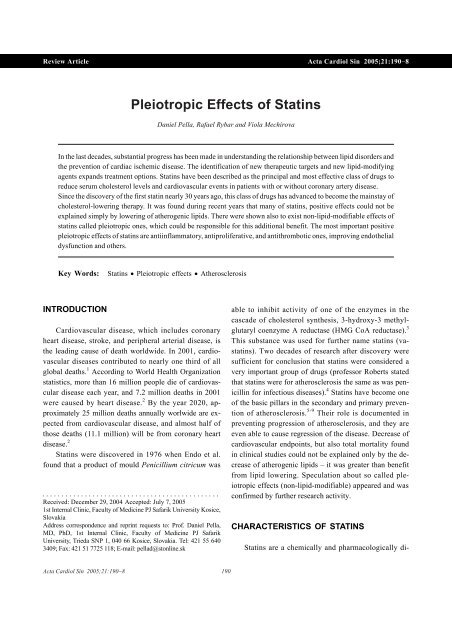
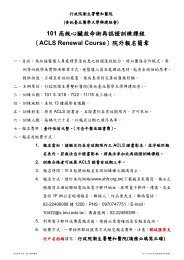
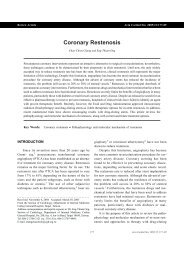
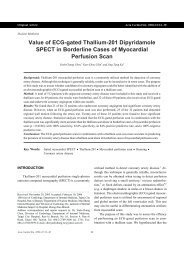

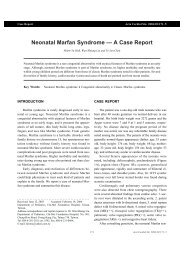
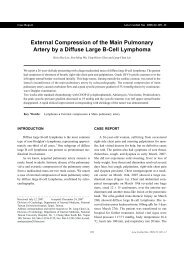
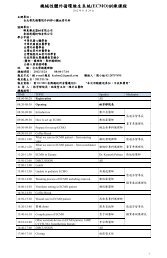
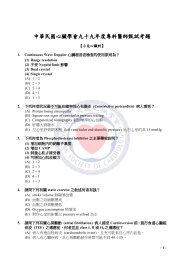

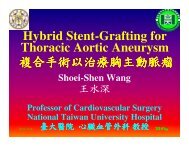
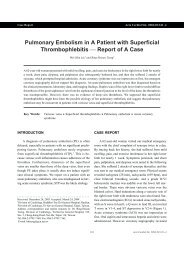
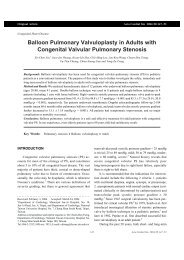
![Full Text [Download PDF]](https://img.yumpu.com/22999153/1/190x260/full-text-download-pdf.jpg?quality=85)